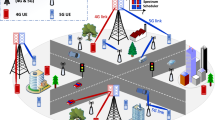Abstract
The exponential growth of various services demands the increased capacity of the next-generation broadband wireless access networks, which is toward the deployment of femtocell in macrocell network based on orthogonal frequency division multiple access. However, serious time-varying interference obstructs this macro/femto overlaid network to realize its true potential. In this article, we present a macro services guaranteed resource allocation scheme, which can mitigate various dominant interferences and provide multiple services in macro/femto overlaid Third-Generation Partnership Project Long Term Evolution-Advanced networks. We model our multiple services resource allocation scheme into a multiobjective optimization problem, which is a non-deterministic polynomial-time (NP)-hard problem. Then, we give a low-complexity algorithm consisting of two layers based on chordal graph. Simulation results verify that the proposed scheme can achieve better efficiency than the previous works and raise the satisfaction ratio of Guaranteed Bit Rate (GBR) services while improving the average performance of non-GBR services.
Similar content being viewed by others
References
Andrews J G, Claussen H, Dohler M, et al. Femtocells: past, present, and future. IEEE J Sel Area Commun, 2012, 30: 497–508
Saquib N, Hossain E, Le L B, et al. Interference management in ofdma femtocell networks: issues and approaches. IEEE Commun Mag, 2012, 19: 86–95
Ghosh A, Andrews J G, Mangalvedhe N, et al. Heterogeneous cellular networks: from theory to practice. IEEE Commun Mag, 2012, 50: 54–64
Andrews M, Capdevielle V, Feki A, et al. Autonomous spectrum sharing for mixed LTE femto and macro cells deployments. In: Proceedings of INFOCOM IEEE Conference on Computer Communications Workshops, San Diego, 2010. 1–5
Cheung WC, Quek T Q S, Kountouris M. Throughput optimization, spectrum allocation, and access control in two-tier femtocell networks. IEEE J Sel Area Commun, 2012, 30: 561–574
Chu X L, Wu Y H, Lopez-Perez D, et al. On providing downlink services in collocated spectrum-sharing macro and femto networks. IEEE Trans Wirel Commun, 2011, 10: 4306–4315
Chandrasekhar V, Andrews J G. Spectrum allocation in tiered cellular networks. IEEE Trans Commun, 2009, 57: 5314–5327
Ko C H, Wei H Y. On-demand resource-sharing mechanism design in two-tier OFDMA femtocell networks. IEEE Trans Veh Technol, 2011, 60: 1059–1071
Li H J, Xu X D, Hu D, et al. Graph method based clustering strategy for femtocell interference management and spectrum efficiency improvement. In: Proceedings of the 6th International Conference on Wireless Communications Networking and Mobile Computing, Chengdu, 2010. 1–5
Li H J, Xu X D, Hu D, et al. Clustering strategy based on Graph method and power control for frequency resource managment in femtocell and macrocell overlaid system. J Commun Netw, 2011, 13: 664–677
Poongup L, Taeyoung L, Jangkeun J, et al. Interference management in LTE femtocell systems using fractional frequency reuse. In: Proceedings of the International Conference on Advanced Communication Technology, Gangwon-Do, 2010. 1047–1051
Sundaresan K, Rangarajan S. Efficient resource management in OFDMA femto cells. In: Proceedings of the 10th ACM International Symposium on Mobile ad hoc Networking and Computing, New Orleans, 2009. 33–42
Bharucha Z, Haas H, Auer G, et al. Femto-cell resource partitioning. In: Proceedings of IEEE GLOBECOM Workshops, Honolulu, 2009. 1–6
Lee T H, Huang Y W. Resource allocation achieving high system throughput with QoS support in OFDMA-based system. IEEE Trans Commun, 2012, 60: 851–861
Kim Y, Son k, Chong S. QoS scheduling for heterogeneous traffic in OFDMA-based wireless systems. In: Proceedings of IEEE GLOBECOM, Honolulu, 2009. 1–6
Liang Y S, Chung W H, Ni G K, et al. Resource allocation with interference avoidance in OFDMA femtocell networks. IEEE Trans Veh Technol, 2012, 61: 2243–2255
Zhu H L, Wang J Z. Chunk-based resource allocation in OFDMA systems-part I: chunk allocation. IEEE Trans Commun, 2009, 57: 2734–2744
Zhu H L, Wang J Z. Chunk-based resource allocation in OFDMA systemspart II: joint chunk, power and bit allocation. IEEE Trans Commun, 2012, 60: 499–509
Weber S, Andrews J G, Jindal N. The effect of fading, channel inversion, and threshold scheduling on ad hoc networks. IEEE Trans Inf Theory, 2007, 53: 4127–4149
Arslan M Y, Yoon J, Sundaresan K, et al. FERMI: a femtocell resource management system for interference mitigation in OFDMA networks. In: Proceedings of the 17th Annual International Conference on Mobile Computing and Networking, Las Vegas, 2011. 25–36
Blair J R, Peyton B. An introduction to chordal graphs and clique trees. In: George A, Gilbert J R, Liu J W H, eds. Graph Theory and Sparse Matrix Computation. New York: Springer, 1993. 1–29
Berry A, Blair J R, Heggernes P, et al. Maximum cardinality search for computing minimal triangulations of graphs. J Algorithmica, 2004, 39: 287–298
Berry A, Heggernes P, Villanger Y. A vertex incremental approch for dynamically maintaining chordal graphs. In: Proceedings of the International Symposium in Algorithms and Computation, Kyoto, 2003. 47–57
Author information
Authors and Affiliations
Corresponding author
Rights and permissions
About this article
Cite this article
Meng, Y., Li, J. & Li, H. Efficient resource allocation scheme for multi-service based on interference mitigation in LTE-Advanced networks. Sci. China Inf. Sci. 57, 1–11 (2014). https://doi.org/10.1007/s11432-014-5140-6
Received:
Accepted:
Published:
Issue Date:
DOI: https://doi.org/10.1007/s11432-014-5140-6




